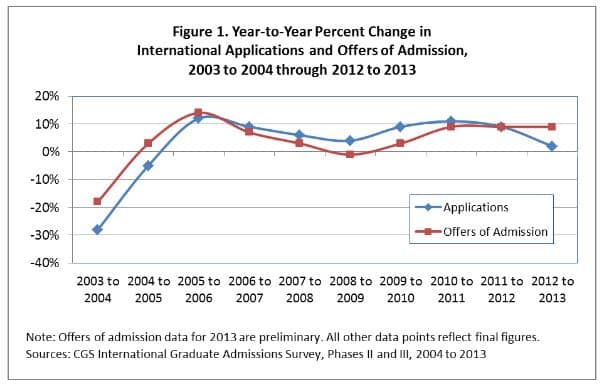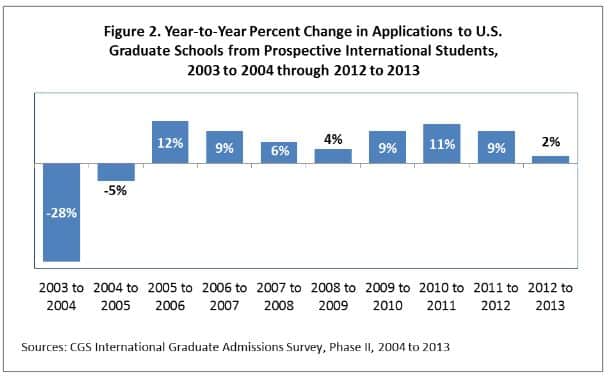US graduate admissions up again this year but applications slowing
Updated data released by the US Council of Graduate Schools (CGS) in August reveals that initial offers of admission from American graduate schools to prospective international students increased 9% from 2012 to 2013, mainly due to strong growth in applications from India and Brazil. Educators and other stakeholders follow the trend line for initial offers of admission closely, as it represents a reliable, if not exact, predictor of actual enrolment for the year. The latest report from CGS reflects the second of a three-part annual survey cycle of US graduate schools. As The Chronicle of Higher Education noted in its report, “The findings are based on responses from 290 graduate schools that were surveyed in June and July. The respondents award a majority of the graduate degrees given to international students in the US and include many of the country's largest graduate institutions.” The 2013 cycle will conclude with a final survey in October designed to capture final data on offers of admission and enrolment for the year. This year’s increase in initial offers of admission follows an increase of 9% last year, and marks the fourth consecutive year of growth in international graduate admissions. However, the latest CGS data also reveals a second more worrying trend:
“For fall 2013, the final overall growth in the number of applications was 2% - much lower than the stronger gains of 9% in 2012 and 11% in 2011 - even as the year-to-year increases in initial offers of admission have remained steady over the 2010-2013 period.
CGS President Debra W. Stewart commented, "For now, the year-to-year decline in applications has not appeared to have a measurable impact on the overall number of international students who are offered admission to US graduate programmes. This is a sign that US graduate programmes continue to see international applicants to US graduate programmes as competitive, high-caliber students.”
This finding updates early statistics for the year that we reported on in April and which provided the first indication of these diverging trends of increasing offers of admissions from US graduate schools and declining growth in applications from international students.


All eyes on the Chinese market
Throughout this year, the decline in the Chinese applicant pool has been one of the most remarked upon findings from the CGS data, one that has educators and industry observers wondering about what the future holds vis-à-vis the longer-term trend for Chinese admissions to American graduate programmes. The Chronicle of Higher Education reports:
“Stewart said the disparity between the two figures does not necessarily mean that graduate schools have been forced to take less-qualified students because the pool of applicants from China is so large. ‘It's an obvious thing to think: Oh, they must be digging deep into the barrel to fill classes,’ she said. ‘You have to understand this is a very big barrel, and the quality at the top of the barrel is very high.’”
And in a separate comment to Inside Higher Ed, Stewart added: "There’s a reason to keep an eye on this, because China is a huge provider of high-quality graduate students to US STEM graduate programmes.”
Reasons for the changes
The most recent CGS survey also asked responding schools to comment on the causes underlying any increases or declines in international applications. Among those institutions reporting significant drops in applications from international students, the most frequently cited causes were:
- increased competition - from online programmes, from other graduate schools in the US, and/or from increased graduate programme options in the students’ home countries;
- funding - particularly financial aid available to international students.
Among those reporting large increases in international applications, the most frequently cited cause was increased recruiting efforts including:
- “targeted recruiting in specific countries or for specific programmes;
- promotion of international programmes;
- aggressive recruiting by the enrolment office;
- recruitment tables at conferences and events;
- improved student outreach;
- using independent recruitment consultants who match students with appropriate institutions.”
Institutions reporting increases in international applications also attributed some of that growth to the overarching strengthening of select global markets for US graduate programmes: “India and Saudi Arabia were most frequently mentioned in this category, and Brazil, China, Egypt, Iraq, Iran, Mexico, the Middle East, and Africa were also mentioned.”
















